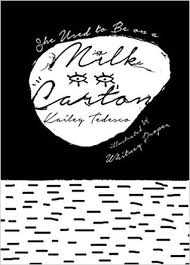She Used to Be on a Milk Carton by Kailey Tedesco, Illustrations by Whitney Proper, April Gloaming Press, 2018, 104 pages.
Reviewed by Jennifer Martelli.

In her poem, “On My Girl,” Kailey Tedesco writes, “Around the time of my mother’s hemorrhage,/my mood ring filled with bees.” Bees and cauls, mothers (or, Mothers), mirrors and rings, rebirth, both divine and macabre, are the obsessions that whip us in Tedesco’s collection, She Used to Be on a Milk Carton. When I read the title, I thought of missing children; when I read the book, I thought of Laddie, the little vampire on the milk carton in The Lost Boys. I realized I was entering a magical world of red-hot liquid, circular as a drop of blood. The lost girl is “saved” at the end, “in reverse-baptism—” when she discovers
the hole in the world was a grave
& the fingers, still sputtering dust clouds,
will be the last to fold in bloom antipode.
Birth and re-birth are depicted at times with religious imagery. In “Purity Ring,” the speaker melts and melds metal, creating circles of regeneration:
You are the word for emptying
rings from each finger
into a ceramic bowl like a stream
of urine.
I stay awake praying to Christ
in a bronze doze & lament
//
nuzzling to make you lonely
against the babes of resurrection.
The vampire—a creature who drinks spilled blood—is another resurrected creature, a “vamp,” burlesque performer, reborn:
If I could have one do-over, I’d have vampires
there in vamp-face crouching over
glass & your own slow breathes. You’d be
sired by morning. Fresh-faced as you pluck
asphalt from your elbows, a mug
of blood in your hands.
The images of the caul—the amniotic membrane enclosing a newborn’s face, signifying magical qualities—reinforces the idea of birth, of the mother, and of magic. “Caul” is also a term for a veil, like the one worn by St. Mary. One of the stark illustrations by Whitney Proper is of a veiled (cauled) woman, rising from liquid. Like so much of the imagery in She Used to Be on a Milk Carton, the caul is at times gruesome, “I ate the rabbit’s innards & I ate/the caul,” at times, life-saving:
I could survive the drowning. After all
the caul bathed me before
you did—
The speaker claims, “My mother says I’m a caul-bearer.” But who is this mother—or Mother? Who is she, or She?
I am always two
or three things—I was born inside
another woman
& she said I felt like a Ouija board.
The M/mother is often a double, “I wish I were siamese with the statue/of Mary,” the speaker muses, though later admits, “It’s so easy to forget/I look nothing like my mother—.” The maternal/female is exalted by the poet’s use of capitalization—She, Her—and by the character, “Eureka,” the leader of a coven. Eureka, “not quite dead,” inhabits a “world of velvet—the Mother with arms & legs spread.” Tedesco underscores the viscosity of this world with the ever-changing stone of a mood ring which, “will always return fertile with the smeared hologram/of Eureka & her bodies. This is a promise.”
This liquid state—mood rings, blood, oceans—is a constant in Tedesco’s changing world. Like Plath’s Ariel, this is a female universe, where grief informs language and imagery. There is danger, but also beauty and play. In “Room at the Madonna Inn,” Tedesco stanches the movement:
The cinema plays La Double Vie de Veronique
She & she the teeth between scarlet curtains.
The cinemas all stop
shush
can’t you hear the real bees?
The reflective surfaces of water and mirrors conflate in this velvet world, where the speaker holds “grandmother’s pond/like a hand-mirror.” But, this reflection can be dangerous, capable of drowning:
Light decides to float on the surface instead of looking inside. . . .Still, I wonder how we would have found you in all that copper water, lead-heavy & stamped with everything it wants to devour.
The speaker stares into moving surfaces—a pond, flat champagne, blood—in search of a mother, the Mother, a self.
I found myself sitting back after reading each poem, amazed at how how the language refused its boundaries. The obsessive grief in the speaker’s search infuses the poems, injecting “the gem with color.” Like a golden snake eating its own tail, She Used to Be on a Milk Carton is the ourobos—alchemical and introspective.
We can
spend our whole lives shouting Bloody Mary
into mirrors, hoping she’ll pop by & bring
us through the other side, but chrome is as murky
as any above-ground pool. All my life, I’ve been
chasing vermin home, only to wake up
exactly where I stand.
We are challenged to “Try to walk through that red world/without getting wet.” In Tedesco’s moonstone landscape, it is impossible not to get wet.

